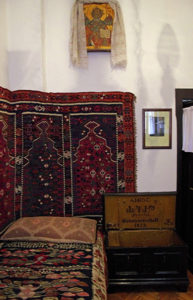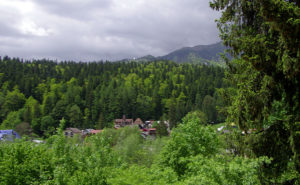George Enescu is regarded as the most significant Romanian composer of the C20th. He benefitted from the support of Queen Elisabeth of Romania and often performed for her at Peles Castle. He built a house in Sinaia where he composed much of his music. He left Romania in 1946 to live in Paris and left his house to the State to become a place of creation and recreation for artists. The house was opened as a museum in 1995.
The house was built between 1923-6 and is a mix of Romanian and Art Deco architecture. It is a very attractive white washed building with a round tower at one end. It has wonderful views across the mountains. Inside it is furnished with late C19th furniture.
The rooms on the ground floor are furnished much as they would have been when Emescu lived here. The first room is the reception and dining room. It is a cheerful room with bright red carpet and upholstery and tapestries on the walls. The table extends to seat 12 people.
Beyond is the sitting room which is the largest room in the house. This contains the grand piano played by Enescu to entertain family and friends. The furniture is walnut with yellow velvet upholstery. A spiral staircase in the base of the tower leads up to Enescu’s study and an observation room with views across the railway line to the mountains.
Beyond, a corridor leads to the bedroom of Enescu’s wife Maruca. Maruca was the daughter of a rich landowner on Moldavia and had married the eldest son of Prince George Cantacuzino. They had led separate lives until her husband’s death in a car crash. Enescu fell passionately in love with her. Her bedroom is simply furnished and has a small bathroom off it. Enescu’s bedroom next door is much smaller with dramatically coloured wall hanging and bed spread.
Stairs lead up to the attic rooms which are scantily furnished, with one of the rooms containing an exhibition of his work.
The tour ends in the basement which has an art exhibition of glass icons produced by students at Bucharest on the walls when we visited. Chairs are set out in rows and recordings of music by Enescu were playing.
This is an attractive house with some nice furniture. It is probably not a ‘must see’ unless you are particularly interested in the life and work of Enescu. The house is open daily except Mondays from 9-3. There is a charge to enter and a 30Lei charge for photographs. There are more pictures “here.”:http://wasleys.org.uk/eleanor/otherholidays/romania/day_nine/nine_one/index.html
We visited on our way from Brasov to Bucharest, during an eight day visit to Romania. My full report with all my pictures is “here.”:http://wasleys.org.uk/eleanor/otherholidays/romania/index.html









